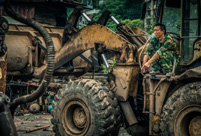 Chinese Kung Fu charms Silicon Valley
Chinese Kung Fu charms Silicon Valley
 Tranquil Yankou ancient town
Tranquil Yankou ancient town
 Lake Geneva: A show of swans
Lake Geneva: A show of swans
 Beautiful sunset over the Irtysh River
Beautiful sunset over the Irtysh River
 Qingjing Mosque: Witness of the ancient Maritime Silk Road
Qingjing Mosque: Witness of the ancient Maritime Silk Road
 Neiliansheng – more than 100 years of fashion
Neiliansheng – more than 100 years of fashion
 Golden retriever feeds baby African lions
Golden retriever feeds baby African lions
 Strange rocks in Lama Mountain
Strange rocks in Lama Mountain
 First overseas "China-standard" electric railway laid
First overseas "China-standard" electric railway laid
 College graduate launches organic agricultural cooperative in hometown
College graduate launches organic agricultural cooperative in hometownHEFEI, May 27 -- An international dialogue on the use of space technologies in World Heritage protection kicked off on Tuesday at China's Mount Huangshan, a UNESCO natural and cultural heritage site and global geopark.
Representatives of UNESCO-designated places, including World Heritage Sites, Biosphere Reserves and UNESCO-affiliated Global Geoparks, gathered together for the first time for a four-day dialogue.
The dialogue is aimed at boosting communication and cooperation among UNESCO-designated sites, and enhancing protection, management and sustainable development of these places through space technologies, said Hong Tianhua, secretary-general of the dialogue's organizing committee.
As the number of UNESCO-designated places has increased in recent years, their protection and management have become more challenging. The rapid development of space technologies, such as aeronautical, astronautical and ground-based monitoring, has made them one of the key means of solving global environmental and development issues, said Hong, also executive deputy director of the International Center on Space Technologies for Natural and Cultural Heritages (HIST).
Established in July 2011, the Beijing-based HIST is under the auspices of UNESCO and hosted by the Institute of Remote Sensing and Digital Earth (RADI) of the Chinese Academy of Sciences (CAS). It aims to provide technical services to UNESCO and its member states on the use of space technologies for UNESCO-designated places.
More than 160 representatives from such sites in 23 countries attended the dialogue, which was organized by the HIST and RADI and hosted by the Mount Huangshan Administrative Committee.
Kishore Rao, director of UNESCO's World Heritage Centre, said the most commonly encountered management challenges for World Heritage sites are lack of clarity on boundaries, unauthorized construction and development, illegal use of resources and extractive activities, as well as building of transport infrastructure.
"All these factors are responsive to the use of space technologies, which can be important tools for planning, management and monitoring purposes," Rao said.
Space technologies can provide a current view of an ongoing natural or man-made disaster to enable managers to plan for effective response and mitigation measures, as well as time-series imagery to observe the evolution of phenomena or threats such as encroachments, deforestation, degradation and collapse, unauthorized construction, and flooding to contribute to the devising of appropriate response strategies, he said.
Guo Huadong, a CAS academic and director with the HIST, said space technologies are better than ground monitoring when it comes to large heritages sites, such as the Great Wall and the Silk Road. Dynamic and consecutive data collected by space technologies will also serve as important references while evaluating the protection efforts of a World Heritage site, he added.
Considering the high cost of space technology and related products, such as satellite images and aerial photographs, Rao advised agencies to provide such products for World Heritage conservation and management purposes as a part of their corporate social responsibility agenda and make them available free of charge to those users who cannot afford them.
 Opening ceremony of 67th Cannes Film Festival
Opening ceremony of 67th Cannes Film Festival Pulse of Xiamen - Int'l Yoga art festival in May
Pulse of Xiamen - Int'l Yoga art festival in May Photo story: Life of a scrap metal recycle worker
Photo story: Life of a scrap metal recycle worker Training of the PLA's first female honor guard
Training of the PLA's first female honor guard China's 10 must-see animations
China's 10 must-see animations Female bodybuilders show their beauty of fitness
Female bodybuilders show their beauty of fitness A taste of Harbin cuisine
A taste of Harbin cuisine A bite of Jiang Nan
A bite of Jiang Nan Who is China's campus beauty queen?
Who is China's campus beauty queen? 8 great movies to watch with your mom
8 great movies to watch with your mom China's most luminous celebrities
China's most luminous celebrities Newly recruited police in Hetian hold drill
Newly recruited police in Hetian hold drill  Bird-men compete flying in Hong Kong
Bird-men compete flying in Hong Kong  The 'Chinese Dad'
The 'Chinese Dad' Shanghai locals bid farewell to childhood memories
Shanghai locals bid farewell to childhood memoriesDay|Week|Month